The Effect of Agulhas Eddies on Absorption and Transport of Anthropogenic Carbon in the South Atlantic Ocean
Abstract
1. Introduction
2. Data and Methods
2.1. Cruises Surveys
2.2. Identification of the Agulhas Eddies
2.3. Carbonate System Sampling and Analysis
2.3.1. A10_2003 Cruise
2.3.2. A10_2011 Cruise
2.4. Polynomial Model Development for Carbonate System Parameters
2.5. Anthropogenic Carbon Estimate
3. Results
3.1. Physical Structure and Hydrographic Properties along the Cruise Tracks
3.2. Polynomial Models for Carbonate System Parameters
3.3. Anthropogenic Carbon Content
3.4. Characteristics and Physical-Chemical Structure of the Agulhas Eddies
4. Discussion
4.1. Polynomial Models for Carbonate System Parameters
4.2. Anthropogenic Carbon Content in the South Atlantic Ocean
4.3. Role Played by the Agulhas Eddies in Anthropogenic Carbon Transport in the South Atlantic Ocean
5. Summary and Conclusions
Author Contributions
Funding
Acknowledgments
Conflicts of Interest
References
- Campos, E.J.D.; França, C.A.S.; Rodrigues, R.R.; Muelbert, J.H. Inter-relações entre o Atlântico Sul, plataforma continental e regiões costeiras do sul e do sudeste do Brasil. In Ciência das Mudanças Climáticas e sua Interdisciplinaridade; Ambrizzi, T., Jacobi, P.R., Dutra, L.M.M., Eds.; Annablume Editora: São Paulo, Brazil, 2015; ISBN 978-85-391-0714-8. [Google Scholar]
- Takahashi, T.; Sutherland, S.C.; Wanninkhof, R.; Sweeney, C.; Feely, R.A.; Chipman, D.W.; Hales, B.; Friederich, G.; Chavez, F.; Sabine, C.; et al. Climatological mean and decadal change in surface ocean pCO2, and net sea-air CO2 flux over the global oceans. Deep-Sea Res. II 2009, 56, 554–557. [Google Scholar] [CrossRef]
- Salt, L.A.; Heuven, S.M.; Claus, M.E.; Jones, E.M.; Baar, H.J. Rapid acidification of mode and intermediate waters in the southwestern Atlantic Ocean. Biogeosciences 2015, 12, 1387–1401. [Google Scholar] [CrossRef]
- De Carvalho-Borges, M.; Orselli, I.B.M.; de Carvalho Ferreira, M.L.; Kerr, R. Seawater acidification and anthropogenic carbon distribution on continental shelf and slope of the western South Atlantic Ocean. J. Mar. Syst. 2018. [Google Scholar] [CrossRef]
- Orselli, I.B.M.; Kerr, R.; Ito, R.G.; Tavano, V.M.; Mendes, C.R.B.; Garcia, C.A.E. How fast is the Patagonian shelf-break acidifying? J. Mar. Syst. 2018, 178, 1–14. [Google Scholar] [CrossRef]
- Kitidis, V.; Brown, I.; Hardman-Mountford, N.; Lefèvre, N. Surface ocean carbon dioxide during the Atlantic Meridional Transect (1995–2013): Evidence of ocean acidification. Prog. Oceanogr. 2017, 158, 65–75. [Google Scholar] [CrossRef]
- Gruber, N.; Clement, D.; Carter, B.R.; Feely, R.A.; van Heuven, S.; Hoppema, M.; Ishii, M.; Key, M.R.; Kozyr, A.; Lauvset, S.K.; et al. The oceanic sink for anthropogenic CO2 from 1994 to2007. Science 2019, 363, 1193–1199. [Google Scholar] [CrossRef] [PubMed]
- Howes, E.L.; Joos, F.; Eakin, M.; Gattuso, J.-P. The Oceans 2015 Initiative, Part I: An Updated Synthesis of the Observed and Projected Impacts of Climate Change on Physical and Biological Processes in the Oceans; Studies N°02/15; IDDRI: Paris, France, 2015; p. 52. ISSN 2258-7535. [Google Scholar]
- Pardo, P.C.; Pérez, F.F.; Khatiwala, S.; Ríos, A.F. Anthropogenic CO2 estimates in the Southern Ocean: Storage partitioning in the different water masses. Prog. Oceanogr. 2014, 120, 230–242. [Google Scholar] [CrossRef]
- Sabine, C.L.; Feely, R.A.; Gruber, N.; Key, R.M.; Lee, K.; Bullister, J.L.; Wanninkhof, R.; Wong, C.S.; Wallace, D.W.; Tilbrook, B.; et al. The Ocean Sink for Anthropogenic CO2. Science 2004, 305, 367–371. [Google Scholar] [CrossRef]
- Tanhua, T.; Hoppema, M.; Jones, E.M.; Stöven, T.; Hauck, J.; Dávila, M.G.; Santana-Casiano, M.; Álvarez, M.; Strass, V.H. Temporal changes in ventilation and the carbonate system in the Atlantic sector of the Southern Ocean. Deep-Sea Res. II 2016. [Google Scholar] [CrossRef]
- Cox, P.M.; Betts, R.A.; Jones, C.D.; Spall, S.A.; Totterdell, I.J. Acceleration of global warming due to carbon-cycle feedbacks in a coupled climate model. Nature 2000, 408, 184–187. [Google Scholar] [CrossRef]
- Touratier, F.; Goyet, C.; Houpert, L.; de Madron, X.D.; Lefèvre, D.; Stabholz, M.; Guglielmi, V. Role of deep convection on anthropogenic CO2 sequestration in the Gulf of Lions (northwestern Mediterranean Sea). Deep-Sea Res. I 2016, 113, 33–48. [Google Scholar] [CrossRef]
- Orsi, A.H.; Johnson, G.C.; Bullister, J.L. Circulation, mixing and production of Antarctic bottom water. Prog. Oceanogr. 1999, 43, 55–109. [Google Scholar] [CrossRef]
- Rintoul, S. The Southern Ocean in the Earth System; Smithsonian Institution Scholarly Press: Washington, DC, USA, 2011. [Google Scholar] [CrossRef]
- Talley, L.; Pickard, G.; Emery, W.; Swift, J. Descriptive Physical Oceanography: An Introduction; Elsevier: Boston, MA, USA, 2011. [Google Scholar]
- Emery, W.J. Water types and water masses. In Ocean Circulation; Elsevier: Amsterdam, The Netherlands, 2003; pp. 1556–1567. ISBN 978-0-12-391851-2. [Google Scholar]
- Hanawa, K.; Talley, L.D. Mode Waters. In Ocean Circulation and Climate: Observing and Modelling the Global Ocean; Siedle, G., Church, J., Gould, J., Eds.; Academic: San Diego, CA, USA; London, UK, 2001; pp. 373–386. ISBN 0-12-641351-7. [Google Scholar]
- Van Aken, H.M.; van Veldhoven, A.K.; Veth, C.; De Ruijter, W.P.M.; van Leeuwen, P.J.; Drijfhout, S.S.; Whittle, C.P.; Rouault, M. Observations of a young Agulhas ring, Astrid, during MARE in March 2000. Deep-Sea Res. II 2003, 50, 167–195. [Google Scholar] [CrossRef]
- Souza, A.G.Q.; Kerr, R.; Azevedo, J.L.L. On the influence of Subtropical Mode Water on the South Atlantic Ocean. J. Mar. Syst. 2018, 185, 13–24. [Google Scholar] [CrossRef]
- Beal, L.M. A Time Series of Agulhas Undercurrent Transport. J. Phys. Oceanogr. 2009, 39, 2436–2450. [Google Scholar] [CrossRef]
- Biastoch, A.; Durgadoo, J.V.; Morrison, A.K.; van Sebille, E.; Weijer, W.; Griffies, S.M. Atlantic multi-decadal oscillation covaries with Agulhas leakage. Nat. Commun. 2015, 6, 10082. [Google Scholar] [CrossRef]
- Stramma, L.; England, M. On the Water masses and mean circulation of the South Atlantic Ocean. J Geophys. Res. 1999, 104, 20863–20883. [Google Scholar] [CrossRef]
- Ferreira, M.L.; Kerr, R. Source water distribution and quantification of North Atlantic Deep Water and Antarctic Bottom Water in the Atlantic Ocean. Prog. Oceanogr. 2017, 153, 66–83. [Google Scholar] [CrossRef]
- Robinson, A.R. Eddies in Marine Science; Springer: Berlin, Germany, 1983; 614p. [Google Scholar]
- Biastoch, A.; Böning, C.W.; Lutjeharms, J.R.E. Agulhas leakage dynamics affects decadal variability in Atlantic overturning circulation. Nature 2008, 456, 489–492. [Google Scholar] [CrossRef]
- De Ruijter, W.P.; Biastoch, A.; Drijhout, S.S.; Lutjeharms, J.R.; Matano, R.; Pichevin, T.; van Leeuwen, P.J.; Weijer, W. Dynamics, estimation and impact of South Atlantic interocean exchange. J. Geophys. Res. 1999, 104, 20885–20910. [Google Scholar] [CrossRef]
- Lutjeharms, J.R.E. The Agulhas Current; Springer: Berlin/Heidelberg, Germany, 2006. [Google Scholar] [CrossRef]
- Biastoch, A.; Böning, C.W.; Schwarzkopf, F.U.; Lutjeharms, J.R.E. Increase in Agulhas leakage due to poleward shift of southern hemisphere westerlies. Nature 2009, 462, 495. [Google Scholar] [CrossRef] [PubMed]
- Souza, J.M.; de Boyer Montégut, C.; Cabanes, C.; Klein, P. Estimation of the Agulhas ring impacts on meridional heat fluxes and transport using ARGO floats and satellite data. Geophys. Res. Lett. 2011, 38, L21602. [Google Scholar] [CrossRef]
- Bard, E.; Rickaby, R.E.M. Migration of the subtropical front as a modulator of glacial climate. Nature 2009, 460, 380–383. [Google Scholar] [CrossRef] [PubMed]
- Sato, O.T.; Polito, P. Observation of South Atlantic subtropical mode Waters with Argo profiling float data. J. Geophys. Res. Oceans 2014, 119, 2860–2881. [Google Scholar] [CrossRef]
- Villas Bôas, A.B.; Sato, O.T.; Chaigneau, A.; Castelão, G.P. The signature of mesoscale eddies on the air-sea turbulent heat fluxes in the South Atlantic Ocean. Geophys. Res. Lett. 2015, 42, 1856–1862. [Google Scholar] [CrossRef]
- Orselli, I.B.M.; Kerr, R.; Azevedo, J.L.L.; Galdino, F.; Araujo, M.; Garcia, C.A.E. The sea-air CO2 net fluxes in the South Atlantic Ocean and the role played by Agulhas eddies. Prog. Oceanogr. 2019, 170, 40–52. [Google Scholar] [CrossRef]
- Ríos, A.F.; Álvarez-Salgado, X.A.; Pérez, F.F.; Bingler, L.S.; Arístegui, J.; Mémery, L. Carbon dioxide along WOCE line A14: Water masses characterization and anthropogenic entry. J. Geophys. Res. 2003, 108, 3123. [Google Scholar] [CrossRef]
- Moreau, S.; Della Penna, A.; Llort, J.; Patel, R.; Langlais, C.; Boyd, P.W.; Matear, R.J.; Phillips, H.E.; Trull, T.W.; Tilbrook, B.; et al. Eddy-induced carbon transport across the Antarctic Circumpolar Current. Glob. Biogeochem. Cycles 2017, 31, 1368–1386. [Google Scholar] [CrossRef]
- Mata, M.M.; Tavano, V.M.; Garcia, C.A.E. 15 years sailing with the Brazilian High Latitude Oceanography Group (GOAL). Deep-Sea Res. II 2018, 149, 1–3. [Google Scholar] [CrossRef]
- Lencina-Avila, J.M.; Ito, R.G.; Garcia, C.A.E.; Tavano, V.M. Sea-air carbon dioxide fluxes along 35°s in the Atlantic Ocean and adjacent continental shelves. Deep-Sea Res. I 2016, 115, 175–187. [Google Scholar] [CrossRef]
- Carvalho, A.C.O.; Mendes, C.R.B.; Kerr, R.; Azevedo, J.L.L.; Galdino, F.; Tavano, V.M. The impact of mesoscale eddies on the phytoplankton community in the South Atlantic Ocean: HPLC-CHEMTAX approach. Mar. Environ. Res. 2019, 144, 154–165. [Google Scholar] [CrossRef] [PubMed]
- Uchida, H.; Fukasawa, M.; Murata, A. WHP P6, A10, I3/I4 REVISIT DATA BOOK Blue Earth Global Expedition 2003 (BEAGLE2003); JAMSTEC Publication: Tokyo, Japan, 2005; Volume 1–2. [Google Scholar]
- Wanninkhof, R.; Feely, R.; Millero, F.; Carlson, C.; O’Neil Baringer, M.; Macdonald, A.; Johnson, G.; Zhang, J.-Z.; Mordy, C.; Langdon, C.; et al. Carbon Dioxide, Hydrographic, and Chemical Data Obtained during the R/V Ronald H. Brown in the Atlantic Ocean on CLIVAR Repeat Hydrography Section A10 (September 26—October 31, 2011); Carbon Dioxide Information Analysis Center, Oak Ridge National Laboratory, US Department of Energy: Oak Ridge, TN, USA, 2013. [Google Scholar] [CrossRef]
- Chelton, D.B.; Schlax, M.G.; Samelson, R.G. Global observations of nonlinear mesoscale eddies. Prog. Oceanogr. 2011, 91, 167–216. [Google Scholar] [CrossRef]
- Schlax, M.G.; Chelton, D.B. The “Growing Method” of Eddy Identification and Tracking in Two and Three Dimensions; College of Earth, Ocean and Atmospheric Sciences, Oregon State University: Corvallis, OR, USA, 2016. [Google Scholar]
- DOE. Handbook of Methods for Analysis of the Various Parameters of the Carbon Dioxide System in Seawater; Version 2, ORNL/CDIAC-74; Dickson, A.G., Goyet, C., Eds.; DOE: Washington, DC, USA, 1994. [Google Scholar]
- Johnson, K.M.; Dickson, A.G.; Eischeid, G.; Goyet, C.; Guenther, P.; Key, R.M.; Millero, F.J.; Purkerson, D.; Sabine, C.L.; Schottle, R.G.; et al. Coulometric total carbon dioxide analysis for marine studies: Assessment of the quality of total inorganic carbon measurements made during the US Indian Ocean CO2 survey 1994–1996. Mar. Chem. 1998, 63, 21–37. [Google Scholar] [CrossRef]
- Goyet, C.; Hacker, S.D. Procedure for calibration of a coulometric system used for total inorganic carbon measurements in seawater. Mar. Chem. 1992, 38, 37–53. [Google Scholar] [CrossRef]
- Johnson, K.M.; King, A.E.; Sieburth, J.M. Coulometric TCO2 analyses for marine studies: An introduction. Mar. Chem. 1985, 16, 61–82. [Google Scholar] [CrossRef]
- Johnson, K.M.; Williams, P.J.; Brandstrom, L.; Sieburth, J.M. Coulometric total carbon analysis for marine studies: Automation and calibration. Mar. Chem. 1987, 21, 117–133. [Google Scholar] [CrossRef]
- Johnson, K.M. Operator’s Manual: Single-Operator Multiparameter Metabolic Analyzer (SOMMA) for Total Carbon Dioxide (CT) with Coulometric Detection; Brookhaven National Laboratory: Brookhaven, NY, USA, 1992. [Google Scholar]
- Patil, G.P.; Rao, C.R. Handbook of Statistics. v. 12; Environmental Statistics: Amsterdan, The Netherlands, 1994; 927p. [Google Scholar]
- Goyet, C.; Healy, R.J.; Ryan, J.P. Global Distribution of Total Inorganic Carbon and Total Alkalinity below the Deepest Winter Mixed Layer Depths; ORNL/CDIAC-127, NDP-076; Carbon Dioxide Information Analysis Center, Oak Ridge National Laboratory, U.S. Department of Energy: Oak Ridge, TA, USA, 2000; p. 40.
- Touratier, F.; Azouzi, L.; Goyet, C. CFC-11, ∆C14C and 3H tracers as a means to assess anthropogenic CO2 concentrations in the ocean. Tellus 2007, 59B, 318–325. [Google Scholar] [CrossRef]
- Touratier, F.; Goyet, C. Definition, properties, and Atlantic Ocean distribution of the new tracer TrOCA. J. Mar. Syst. 2004, 46, 169–179. [Google Scholar] [CrossRef]
- Touratier, F.; Goyet, C. Applying the new TrOCA approach to assess the distribution of anthropogenic CO2 in the Atlantic Ocean. J. Mar. Syst. 2004, 46, 181–197. [Google Scholar] [CrossRef]
- Lutjeharms, J.R.E.; Valentine, H.R. Water types and volumetric considerations of the South-East Atlantic upwelling regime. Afr. J. Mar. Sci. 1987, 5, 63–71. [Google Scholar] [CrossRef][Green Version]
- Möller, O.O., Jr.; Piola, A.R.; Freitas, A.C.; Campos, E.J.D. The effects of river discharge and seasonal winds on the shelf off Southwestern South America. Cont. Shelf Res. 2008, 28, 1607–1624. [Google Scholar] [CrossRef]
- Newton, J.A.; Feely, R.A.; Jewett, E.B.; Williamson, P.; Mathis, J. Global Ocean Acidification Observing Network (GOA-ON): Requirements and Governance Plan, 2nd ed. 2015. Available online: http://www.goa-on.org/documents/general/GOA-ON_2nd_edition_final.pdf (accessed on 12 June 2019).
- Goyet, C.; Davis, D.L. Estimation of TCO2 concentration throughout the water column. Deep-Sea Res. I 1997, 44, 859–877. [Google Scholar] [CrossRef]
- Goyet, C.; Ito, R.G.; Touratier, F. Anthropogenic carbon distribution in the eastern South Pacific Ocean. Biogeosciences 2009, 6, 149–156. [Google Scholar] [CrossRef]
- Goyet, C.; Coatanoan, C.; Eischeid, G.; Amaoka, T.; Okuda, K.; Healy, R.; Tsunogai, S. Spatial variation of total CO2 and total alkalinity in the northern Indian Ocean: A novel approach for the quantification of anthropogenic CO2 in seawater. J. Mar. Res. 1999, 57, 135–163. [Google Scholar] [CrossRef][Green Version]
- Millero, F.J. The marine inorganic carbon cycle. Chem. Rev. 2007, 107, 308–341. [Google Scholar] [CrossRef]
- Casanova-Masjoan, M.; Pelegrí, J.L.; Sangrà, P.; Martínez, A.; Grisolía-Santos, D.; Pérez-Hernández, M.D.; Hernández-Guerra, A. Characteristics and evolution of an Agulhas ring. J. Geophys. Res. Oceans 2017, 122, 7049–7065. [Google Scholar] [CrossRef]
- Kerr, R.; Goyet, C.; Cunha, L.C.; Orselli, I.B.M.; Lencina-Avila, J.M.; Mendes, C.R.B.; Carvalho-Borges, M.; Mata, M.M.; Tavano, V.M. Carbonate system properties in the Gerlache Strait, Northern Antarctic Peninsula (February 2015): II. Anthropogenic CO2 and Seawater Acidification. Deep-Sea Res. II 2018. [Google Scholar] [CrossRef]
- Gruber, N.; Sarmiento, J.L.; Stocker, T.F. An improved method for detecting anthropogenic CO2 in the oceans. Glob. Biogeochem. Cycles 1996, 10, 809–837. [Google Scholar] [CrossRef]
- Kerr, R.; Cunha, L.C.; Kikuchi, R.K.P.; Horta, P.; Ito, R.G.; Muller, M.N.; Orselli, I.B.M.; Lencina-Avila, J.M.; de Orte, M.R.; Sordo, L.; et al. The western South Atlantic Ocean in a high-CO2 world: Current measurement capabilities and perspectives. Environ. Manag. 2016, 57, 740–752. [Google Scholar] [CrossRef]
- Carter, B.R.; Feely, R.A.; Williams, N.L.; Dickson, A.G.; Fong, M.B.; Takeshita, Y. Updated methods for global locally interpolated estimation of alkalinity, pH and nitrate. Limnol. Oceanogr. Methods 2017. [Google Scholar] [CrossRef]
- Perretti, A.R.; Albergaria-Barbosa, A.C.R.D.; Kerr, R.; Cunha, L.C.D. Ocean acidification studies and the uncertainties relevance on measurements of marine carbonate system properties. Braz. J. Oceanogr. 2018, 66, 234–242. [Google Scholar] [CrossRef]
- Laxenaire, R.; Speich, S.; Blanke, B.; Chaigneau, A.; Pegliasco, C.; Stegner, A. Anticyclonic eddies connecting the western boundaries of Indian and Atlantic oceans. J. Geophys. Res. Oceans 2018. [Google Scholar] [CrossRef]
- Guerra, L.A.A.; Paiva, A.M.; Chassignet, E.P. On the translation of Agulhas rings to the western South Atlantic Ocean. Deep-Sea Res. I 2018, 139, 104–113. [Google Scholar] [CrossRef]
- Woosley, R.J.; Millero, F.; Wanninkhof, R. Rapid Anthropogenic Changes in CO2 and pH in the Atlantic Ocean: 2003–2014. Glob. Biogeochem. Cycles 2016, 30, 70–90. [Google Scholar] [CrossRef]
- Lumpkin, R.; Garzoli, S.L. Interannual to Decadal Variability in the Southwestern Atlantic’s Surface Circulation. J. Geophys. Res. Oceans 2003, 116, C01014. [Google Scholar] [CrossRef]
- Rodrigues, R.R.; Haarsma, R.J.; Campos, E.J.D.; Ambrizzi, T. The impacts of inter-El Nino variability on the Tropical Atlantic and Northeast Brazil climate. J. Clim. 2011, 24, 3402–3422. [Google Scholar] [CrossRef]
- Rodrigues, R.R.; Campos, E.J.D.; Haarsma, R.J. The Impact of ENSO in the South Atlantic Subtropical Dipole Mode. J. Clim. 2015, 28, 2692–2705. [Google Scholar] [CrossRef]
- Castellanos, P.; Campos, E.J.D.; Piera, J.; Sato, O.T.; Silva Dias, M.A.F. Impacts of Agulhas Leakage on the Tropical Atlantic Western Boundary Systems. J. Clim. 2017. [Google Scholar] [CrossRef]
- Pereira, J.E.; Wainer, I. A mudança do clima e seus impactos no oceano Atlântico Sul em escala regional. In Ciência das Mudanças Climáticas e sua Interdisciplinaridade; Ambrizzi, T., Jacobi, P.R., Dutra, L.M.M., Eds.; Annablume Editora: São Paulo, Brazil, 2015; ISBN 978-85-391-0714-8. [Google Scholar]
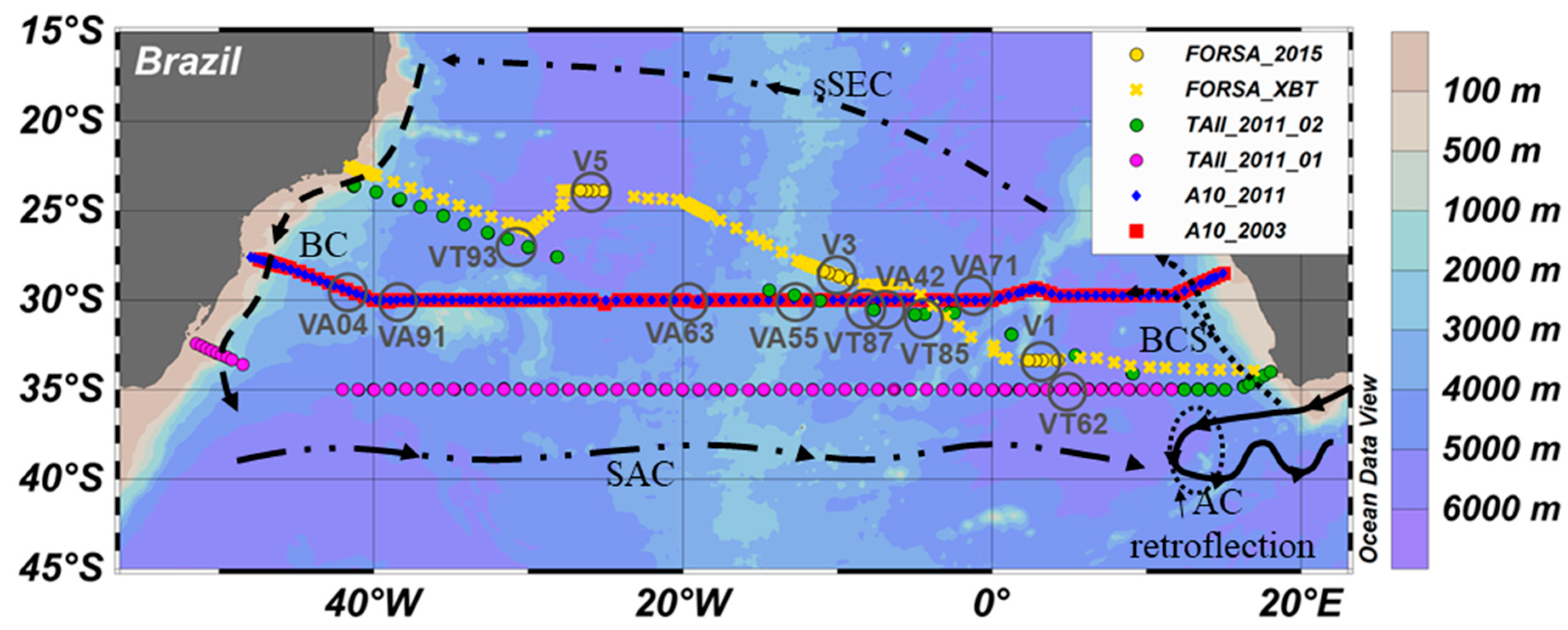
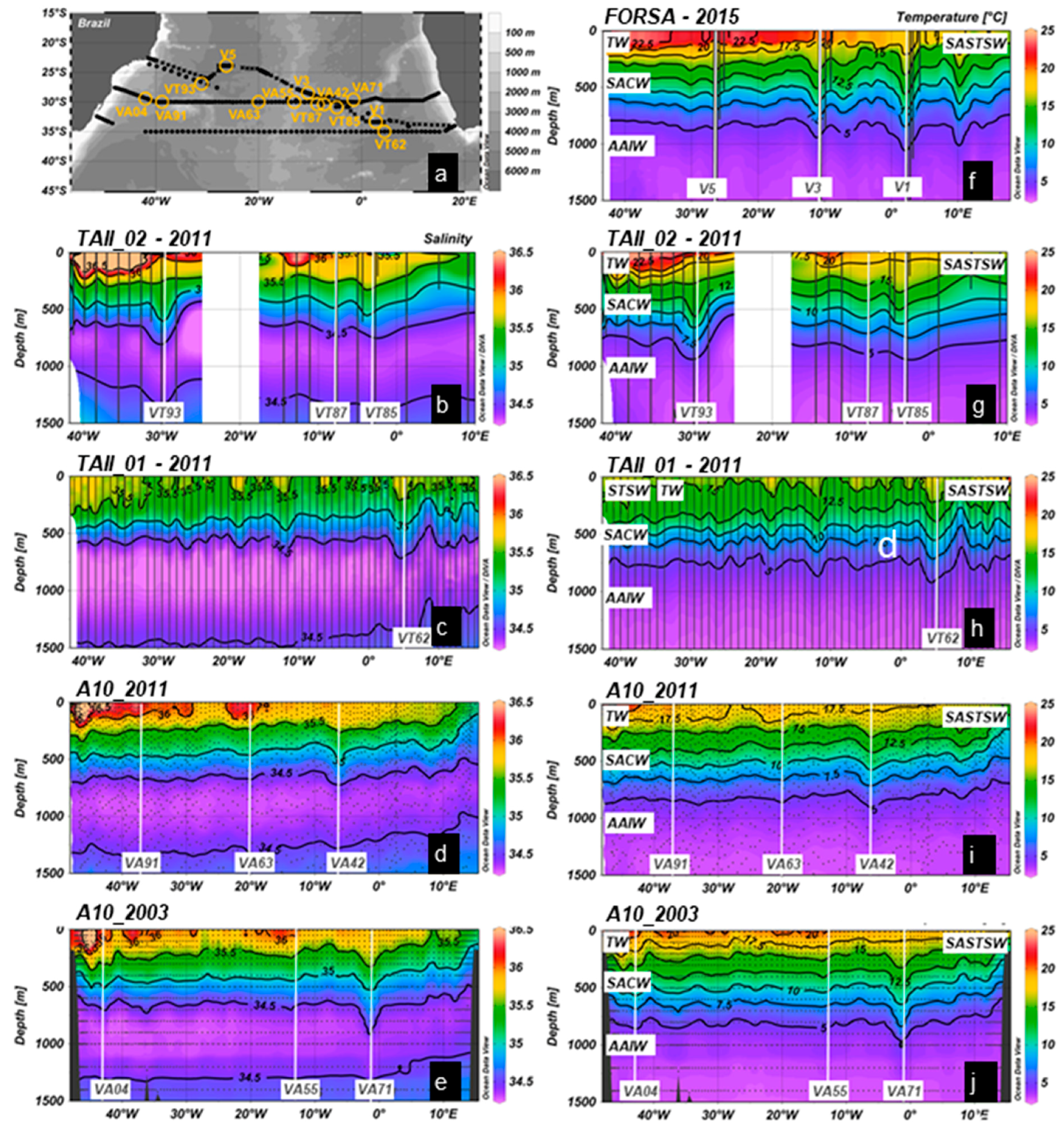
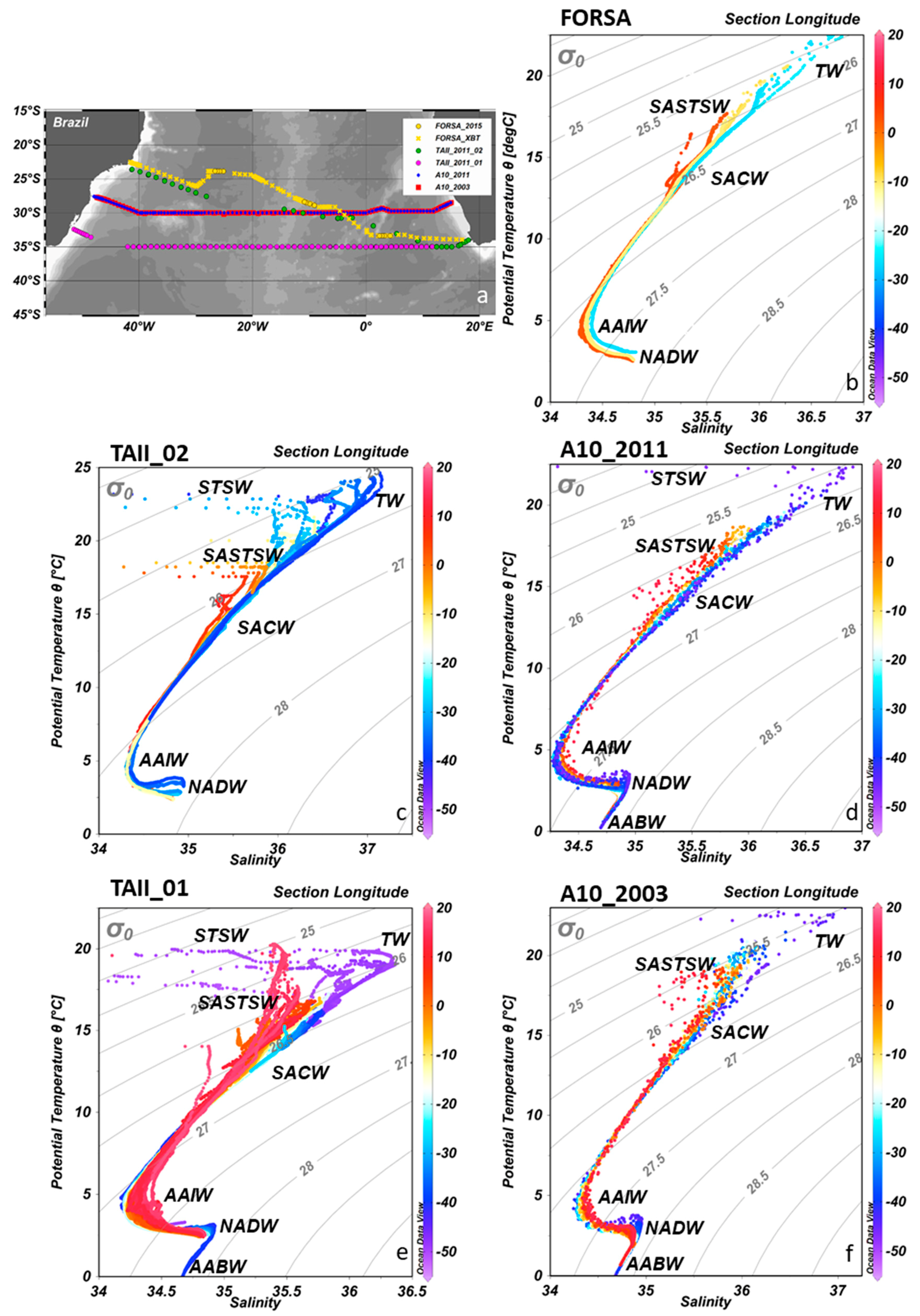
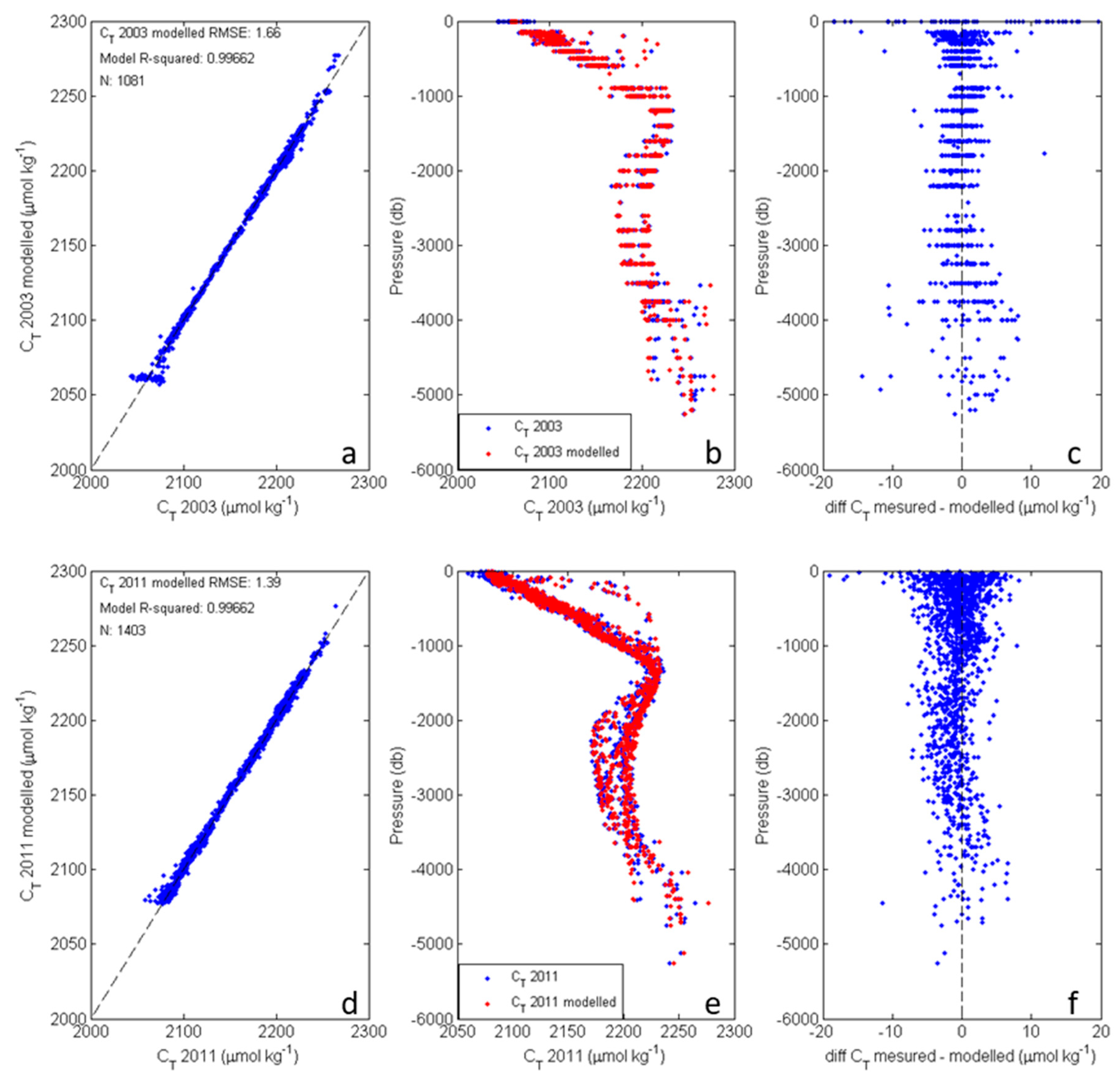
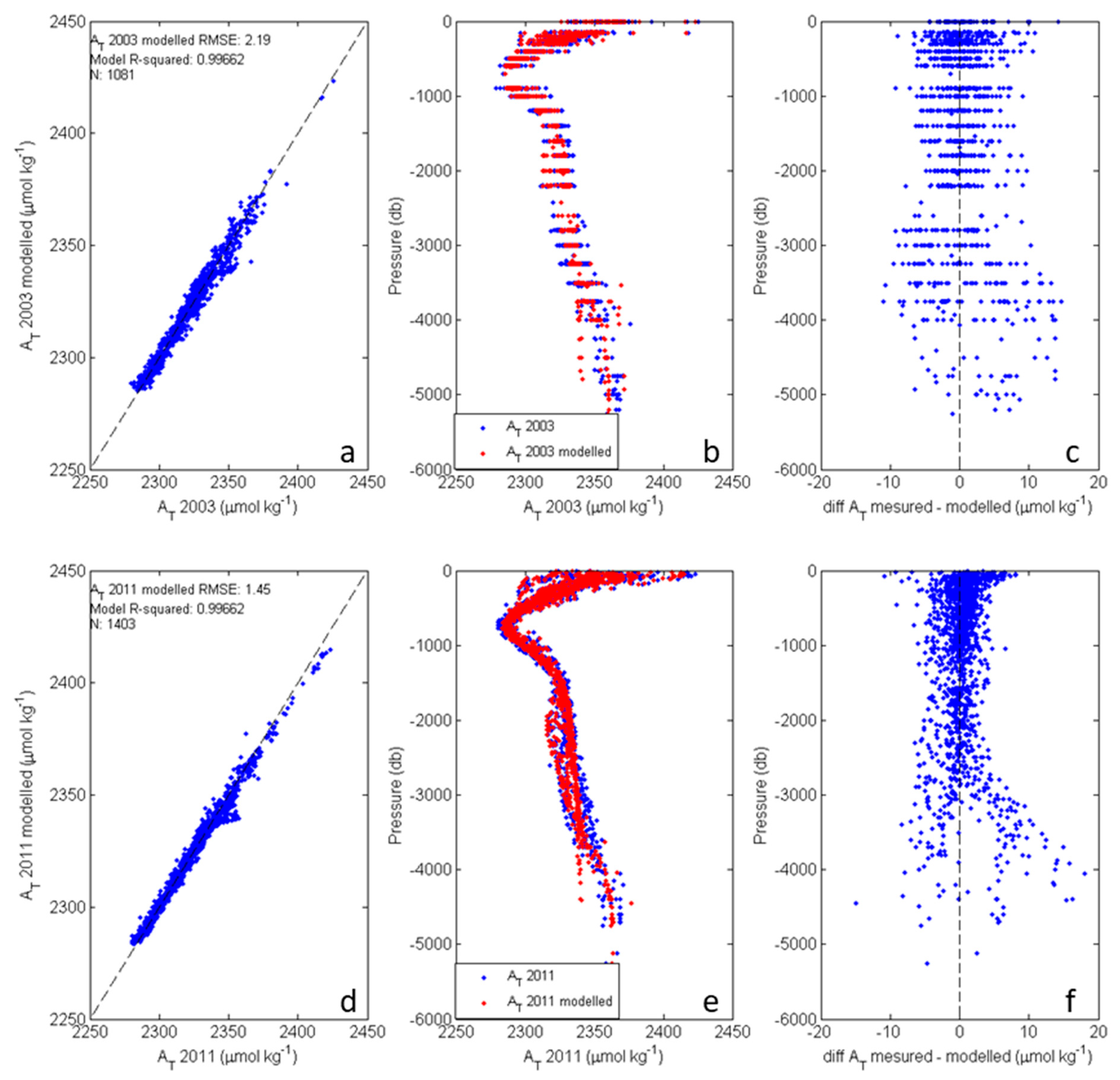
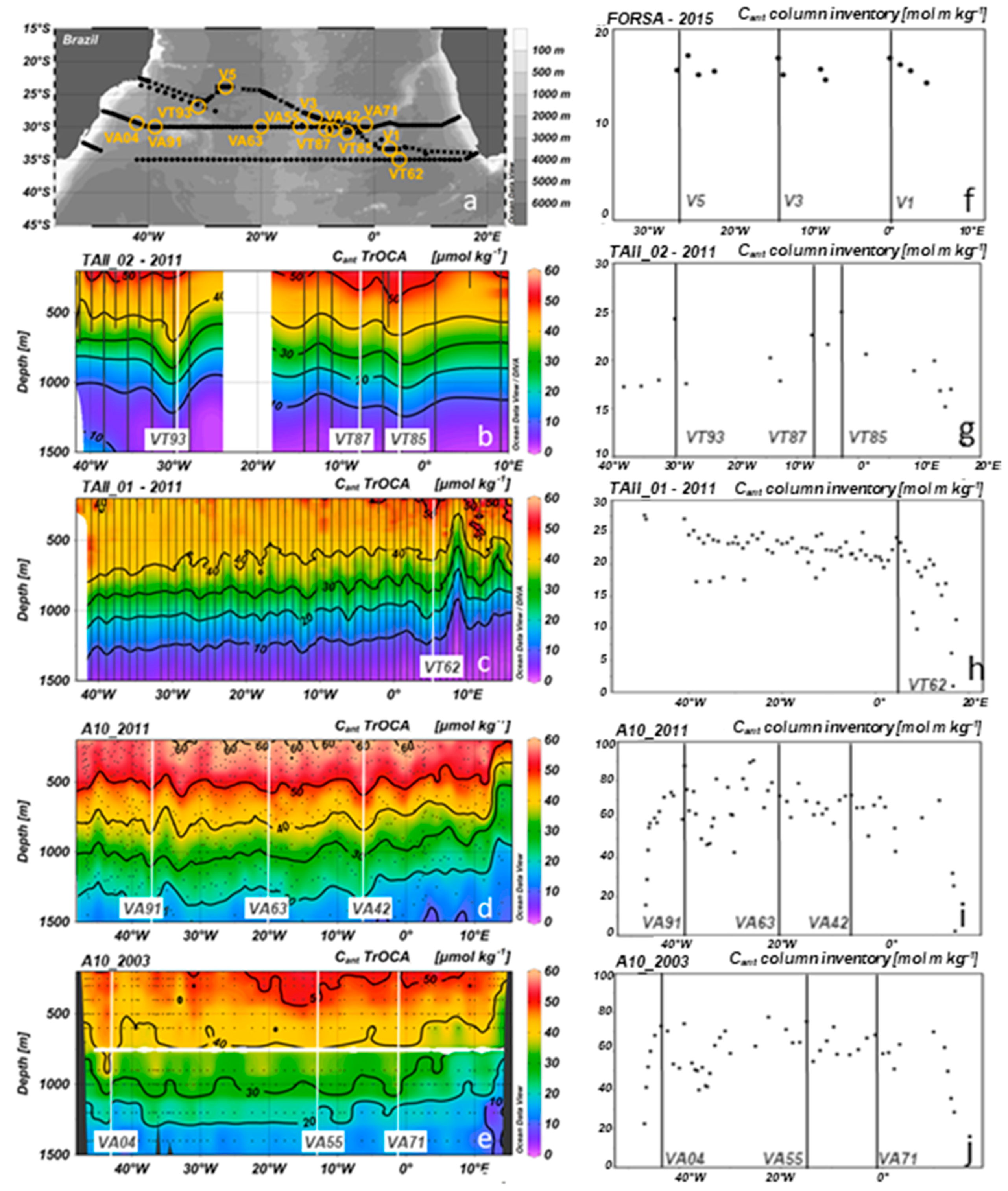
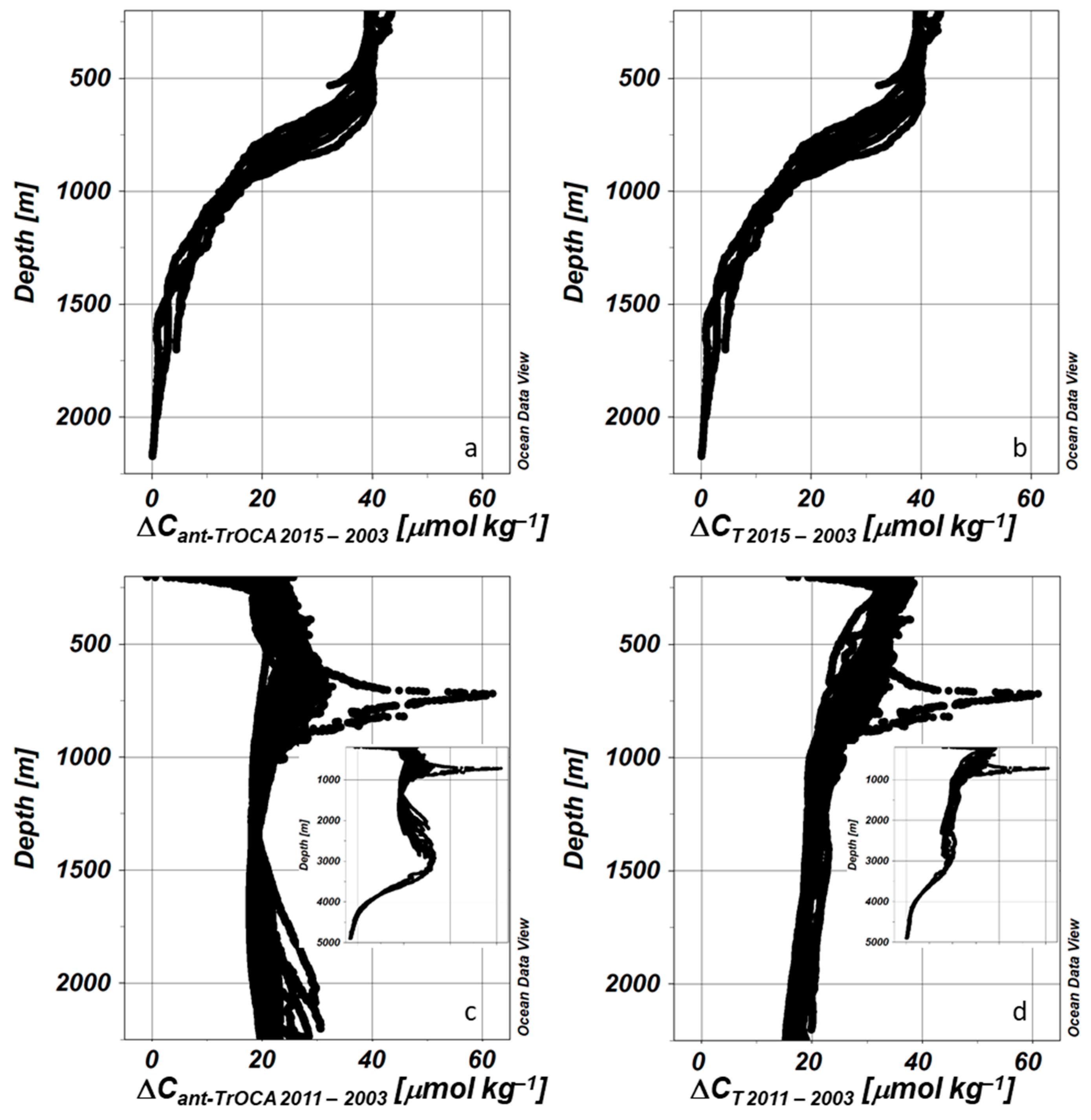
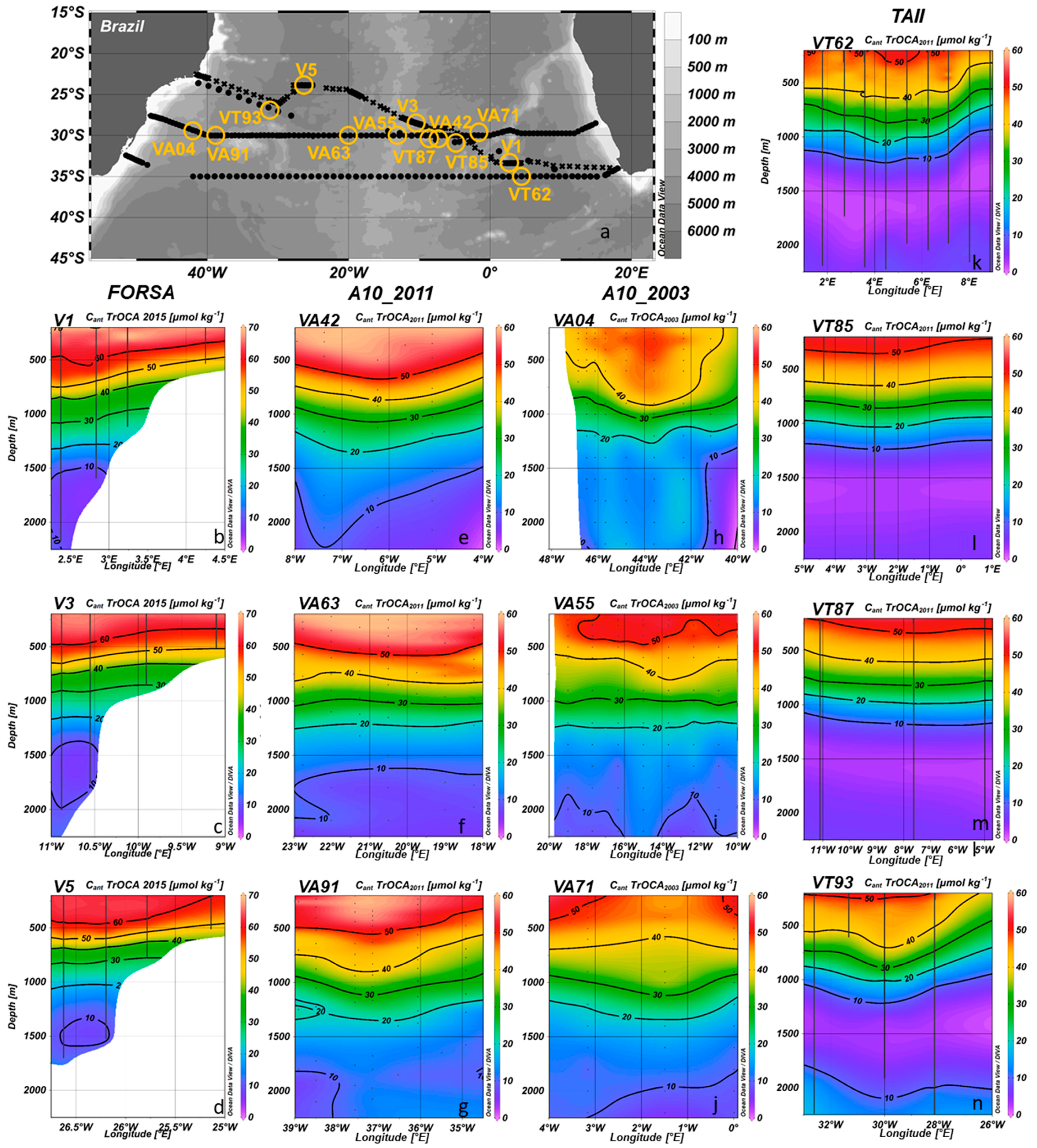
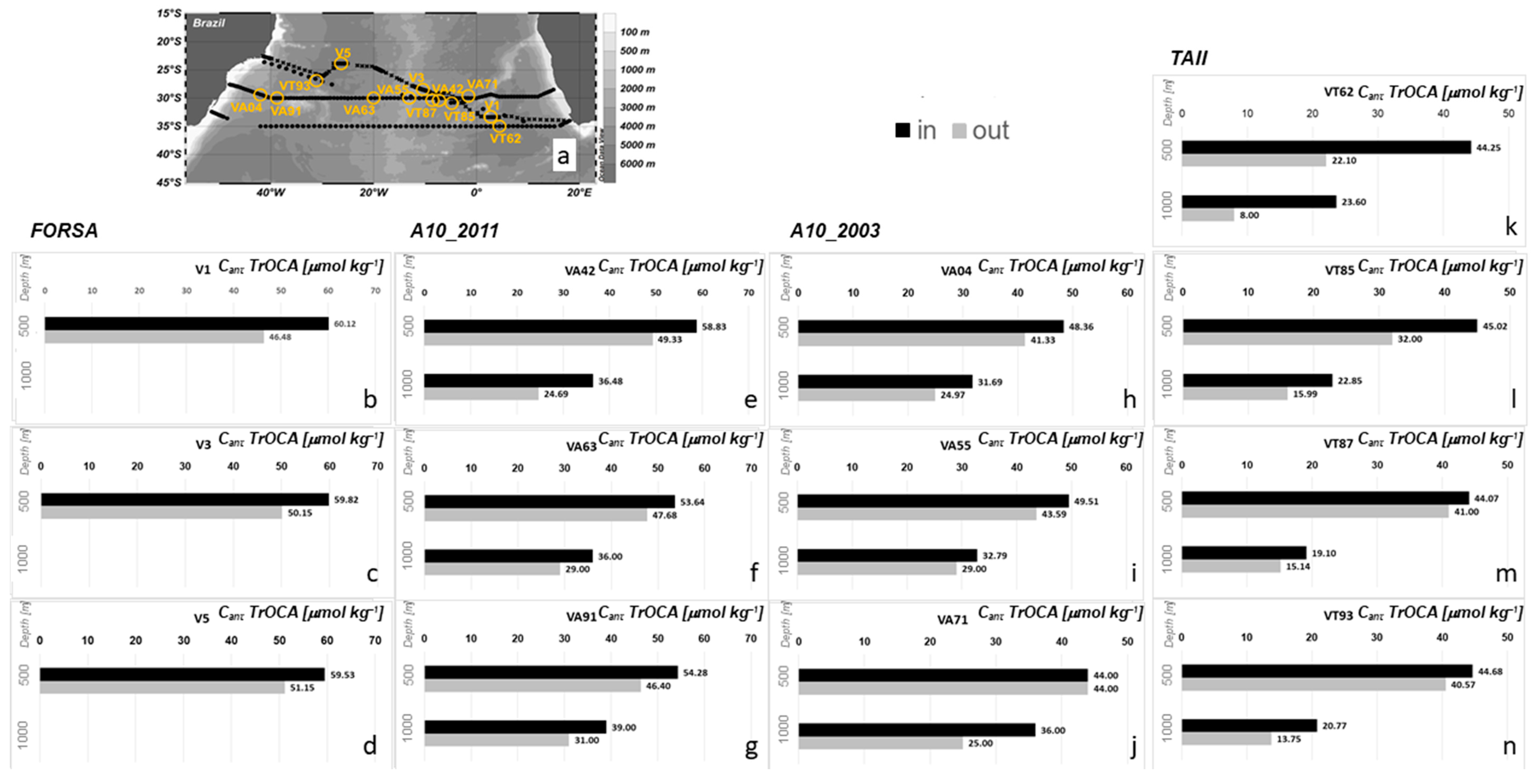
| Cruise Year (Season) | Eddy | Sampled Day | Life History Mean | ||
|---|---|---|---|---|---|
| Radius [km] | Age [d] | Radius [km] | Lifetime [d] | ||
| FORSA 2015 (winter) | V1T | 82.44 | 244 | 94.23 | 798* |
| V3T | 94.30 | 440 | 96.43 | 949 | |
| V5E | 101.86 | 1052 | 98.86 | 1222 | |
| TAII 2011 (early spring) | VT62T | 123.82 | 354 | 106.00 | 367 |
| VT85T | 92.09 | 263 | 87.40 | 767 | |
| VT87T | 95.58 | 245 | 97.47 | 854 | |
| VT93E | 122.06 | 1177 | 101.39 | 1251 | |
| A10 2011 (early spring) | VA42T | 83.72 | 181 | 97.47 | 854 |
| VA63E | 114.92 | 600 | 111.35 | 714 | |
| VA91E | 136.64 | 125 # | 105.34 | 211 # | |
| A10 2003 (late spring) | VA04E | 130.55 | 1177 | 111.11 | 1223 |
| VA55T | 85.43 | 494 | 93.70 | 782 | |
| VA71T | 92.44 | 308 | 96.65 | 874 | |
| Pij | CT 2003 | CT 2011 | AT 2003 | AT 2011 |
|---|---|---|---|---|
| p50 | 5.58 (3.15, 8.00) | −0.75 (−2.90, 1.41) | 23 (14.29, 31.72) | 36.68 (29.17, 44.20) |
| p41 | 20.60 (13.05, 28.15) | 6.95 (0.15, 13.74) | −29.40 (−57.37, −1.43) | −96.18 (−120.20, -72.13) |
| p40 | 0.45 (−2.98, 3.88) | 6.93 (4.43, 9.43) | −7.85 (−20.30, 4.59) | 30.47 (25.75, 35.19) |
| p32 | 24.07 (15.41, 32.73) | 11.43 (3.72, 19.14) | 6.55 (−37.11, 50.21) | 125.40 (89.63, 161.20) |
| p31 | −20.33 (−28.73, −11.93) | −6.88 (−14.14, 0.39) | −18.53 (−46.38, 9.33) | −73.75 (−86.35, −61.15) |
| p30 | −13.24 (−16.48, −9.99) | −3.11 (−5.78, −0.44) | −79 (−91.45, −66.56) | −62.81 (−73.50, −52.12) |
| p23 | 15.78 (11.40, 20.15) | 5.72 (1.32, 10.12) | 4.30 (−32.74, 41.33) | −94.36 (−126.30, −62.47) |
| p22 | −24.29 (−32.38, −16.21) | −9.21 (−18.36, −0.063) | 34.17 (9.75, 58.59) | 44.70 (28.38, 61.01) |
| p21 | 1.77 (−5.61, 9.16) | 9.98 (3.77, 16.19) | 93.98 (70.24, 117.70) | 51.81 (28.92, 74.70) |
| p20 | 12.64 (9.98, 15.30) | 0.72 (−1.50, 2.95) | 24.31 (13.12, 35.50) | −17.50 (−23.39, −11.62) |
| p14 | 5.95 (4.07, 7.83) | 1.48 (−0.75, 3.71) | −1.88 (−17.55, 13.81) | 37.95 (22.51, 53.39) |
| p13 | −16.16 (−22.09, −10.24) | −2.89 (−9.13, 3.35) | −17.88 (−29.89, −5.87) | −5.77 (−17.95, 6.41) |
| p12 | 6.77 (0.13, 13.41) | 0.86 (−4.41, 6.13) | −27.04 (−45.30, −8.77) | 5.61 (−13.96, 25.18) |
| p11 | 1.35 (−2.96, 5.66) | −1.45 (−5.82, 2.93) | 48.87 (36.32, 61.43) | 88.42 (80.30, 96.55) |
| p10 | −25.28 (−26.49, −24.06) | −18.90 (−19.92, −17.88) | 15.52 (11.26, 19.77) | 15.70 (12.27, 19.14) |
| p05 | 0.77 (0.09, 1.44) | −0.01 (−0.58, 0.55) | 0.10 (−2.50, 2.71) | −6.18 (−9.16, −3.19) |
| p04 | −4.93 (−7.30, −2.57) | −0.83 (−2.67, 1.00) | 3.53 (0.72, 6.34) | −1.66 (−5.20, 1.89) |
| p03 | 5.13 (2.26, 8.00) | 0.31 (−1.56, 2.18) | 1.77 (−4.01, 7.54) | −5.85 (−12.48, 0.78) |
| p02 | 1.38 (−1.43, 4.18) | 4.13 (1.50, 6.78) | −35.18 (−41.12, −29.24) | −42.50 (−47.48, −37.52) |
| p01 | 27.71 (26.21, 29.22) | 25.69 (24.39, 26.99) | −18.71 (−23.04, −14.38) | −4.31 (−8.04, −0.58) |
| p00 | 2158 (2158, 2158) | 2156 (2156, 2156) | 2303 (2300, 2306) | 2309 (2308, 2311) |
| Water Column Layer | Water Mass | θ (°C) | Salinity | Reference |
|---|---|---|---|---|
| Surface | Subtropical Shelf Water (STSW) | θ > 14 | 33.5 < S < 35.3 | [56] |
| θ > 18.5 | 35.3 ≤ S < 36 | |||
| Tropical Water (TW) | θ ≥ 18.5 | S ≥ 36 | [56] | |
| South Atlantic Subtropical Surface Water (SASTSW) | θ > 16 | 35.3 ≤ S < 35.7 | [38,55] | |
| Central | South Atlantic Central Water (SACW) | θ < 18.5 | 34.3 < S | [17] |
| Intermediate | Antarctic Intermediate Water (AAIW) | 2 < θ < 6 | 33.8 < S < 34.8 | [17] |
| Deep | North Atlantic Deep Water (NADW) | 1.5 < θ < 4 | 34.8 < S < 35 | [17] |
| Bottom | Antarctic Bottom Water (AABW) | −0.9 < θ < 1.7 | 34.64 < S < 34.72 | [17] |
© 2019 by the authors. Licensee MDPI, Basel, Switzerland. This article is an open access article distributed under the terms and conditions of the Creative Commons Attribution (CC BY) license (http://creativecommons.org/licenses/by/4.0/).
Share and Cite
Orselli, I.B.M.; Goyet, C.; Kerr, R.; Azevedo, J.L.L.d.; Araujo, M.; Galdino, F.; Touratier, F.; Garcia, C.A.E. The Effect of Agulhas Eddies on Absorption and Transport of Anthropogenic Carbon in the South Atlantic Ocean. Climate 2019, 7, 84. https://doi.org/10.3390/cli7060084
Orselli IBM, Goyet C, Kerr R, Azevedo JLLd, Araujo M, Galdino F, Touratier F, Garcia CAE. The Effect of Agulhas Eddies on Absorption and Transport of Anthropogenic Carbon in the South Atlantic Ocean. Climate. 2019; 7(6):84. https://doi.org/10.3390/cli7060084
Chicago/Turabian StyleOrselli, Iole B. M., Catherine Goyet, Rodrigo Kerr, José L. L. de Azevedo, Moacyr Araujo, Felippe Galdino, Franck Touratier, and Carlos A. E. Garcia. 2019. "The Effect of Agulhas Eddies on Absorption and Transport of Anthropogenic Carbon in the South Atlantic Ocean" Climate 7, no. 6: 84. https://doi.org/10.3390/cli7060084
APA StyleOrselli, I. B. M., Goyet, C., Kerr, R., Azevedo, J. L. L. d., Araujo, M., Galdino, F., Touratier, F., & Garcia, C. A. E. (2019). The Effect of Agulhas Eddies on Absorption and Transport of Anthropogenic Carbon in the South Atlantic Ocean. Climate, 7(6), 84. https://doi.org/10.3390/cli7060084





